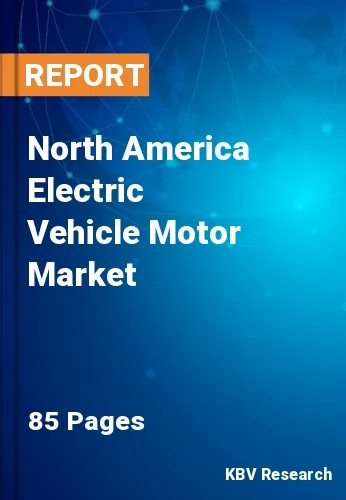The North America Electric Vehicle Motor Market would witness market growth of 20.1% CAGR during the forecast period (2022-2028).
There are two types of current flows, namely alternating current (AC) and direct current (DC), that guide the energy movement in an electric vehicle’s powertrain and thereby, the need for the vehicle’s motor. The two prominent AC motors that are widely used are synchronous and asynchronous (or induction) motors. The major DC motor types are DC series motors and brushless DC motors (BLDC). Technological advancements in motors have produced faster and more efficient motors like permanent magnet synchronous motors (PMSM) and switched reluctance motors (SRM).
The rotor in an induction motor has longitudinal conductive bars or laminations, usually made of copper but occasionally of aluminum. These laminations experience current induction from the stator's RMF, and this electromagnetic field (EMF) eventually starts to rotate inside the stator's RMF. Due to the fact that the induced EMF and the accompanying rotating torque can only exist when the rotor's speed is slower than the RMF, induction motors are sometimes referred to as asynchronous motors.
These types of motors are widely used since they don't require rare-earth magnets and can be produced for a reasonable price. The rotors of permanent-magnet motors have their magnetism. The magnetic field of the rotor may be created with no external power, which makes them far more effective at low speeds. These rotors are also synchronous since they rotate at the same rate as the stator's RMF.
The United States is now well-positioned to lead the EV future, creating employment, increasing domestic production, combating climate change, and achieving environmental justice. This is largely due to President Biden's auto vision and leadership. The President rallied automakers and autoworkers behind the audacious target that by 2030, electric vehicles will account for 50% of all automobiles sold in the US. This economic strategy has encouraged the home production of EVs, chargers for EVs, and batteries, among other strong new "Made in America" laws. The expansion of the regional electric vehicle motor market is thriving as a result of the government's increased efforts to encourage the adoption and manufacture of electric vehicles in regional countries.
The US market dominated the North America Electric Vehicle Motor Market by Country in 2021; thereby, achieving a market value of $3,361.8 Million by 2028. The Canada market is experiencing a CAGR of 22.4% during (2022 - 2028). Additionally, The Mexico market would exhibit a CAGR of 22.1% during (2022 - 2028).
Based on Type, the market is segmented into AC Motor and DC Motor. Based on Application, the market is segmented into Passenger Cars and Commercial Vehicles. Based on Electric Vehicle Type, the market is segmented into Battery Electric Vehicle, Plugin Hybrid Vehicle and Hybrid Vehicle. Based on countries, the market is segmented into U.S., Mexico, Canada, and Rest of North America.
Free Valuable Insights: The Global Electric Vehicle Motor Market is Estimated to reach $19.2 Billion by 2028, at a CAGR of 20.4%
The market research report covers the analysis of key stake holders of the market. Key companies profiled in the report include Bühler Motor GmbH, Inteva Products, LLC (The Renco Group Inc), Mabuchi Motor Co., Ltd., Johnson Electric Holdings Limited, Continental AG, Denso Corporation, Magna International, Inc., Robert Bosch GmbH, Nidec Corporation and MITSUBA Corporation
By Type
By Application
By Electric Vehicle Type
By Country
Our team of dedicated experts can provide you with attractive expansion opportunities for your business.

